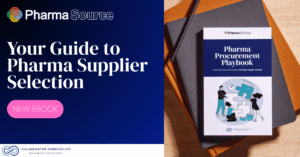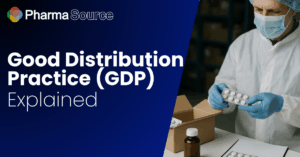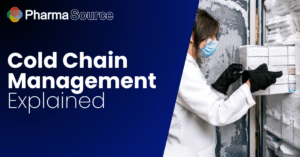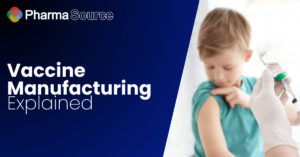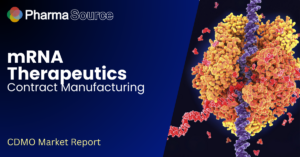The global peptide therapeutics market stands at a pivotal moment in pharmaceutical development. After years of being considered challenging to manufacture and unstable for therapeutic use, peptides have emerged as one of the fastest-growing segments in the pharmaceutical industry.
Peptide therapeutics are a growing class of drugs derived from polypeptides and used to treat a wide range of diseases. Many naturally occurring peptides act as hormones, growth factors, neurotransmitters, and anti-infectives, making them strong foundations for modern peptide-based therapies. Today, more than 100 peptide therapeutics have received FDA approval globally, including notable examples such as Tirzepatide (Mounjaro®), Lutetium Lu-177 vipivotide tetraxetan (Pluvicto®), and Lupkynis™.
The rising incidence of chronic conditions—including diabetes, obesity, osteoarthritis, autoimmune diseases, and cancer—is accelerating the demand for biologics. Peptides and recombinant proteins are increasingly preferred due to their high target specificity, favorable safety profiles, low toxicity, and reduced risk of off-target effects, reinforcing their expanding role in therapeutic development.
Peptide Therapeutics Market Trends-
The peptide therapeutics market reached USD 72.2 billion in 2024 and is projected to grow to USD 162.4 billion by 2035, representing a compound annual growth rate (CAGR) of 6.8%.
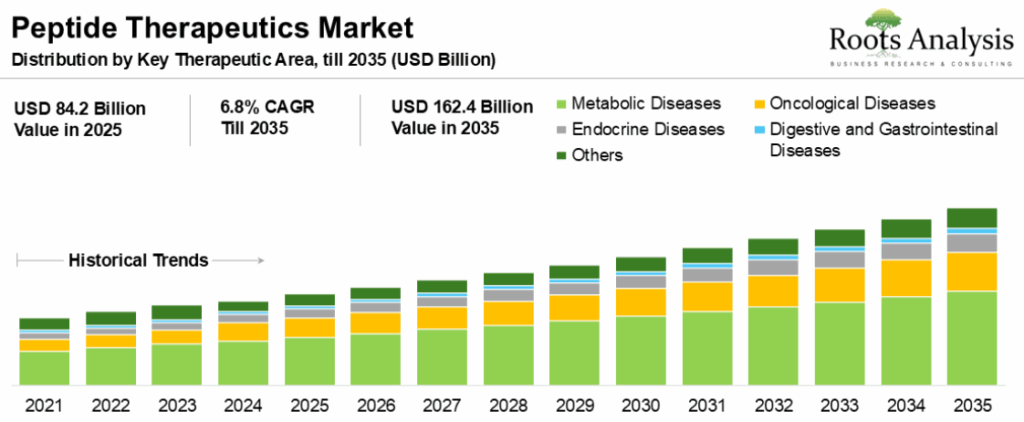
Source- Roots Analysis
The global peptide therapeutics market is entering a phase of explosive growth, projected to soar from an estimated USD $46 billion in 2024 to approximately USD $100 billion by 2034 (Datasource: GLOBE NEWSWIRE). This rapid expansion is fundamentally driven by two key factors: a surge in therapeutic demand and profound innovations in manufacturing and delivery. A primary market catalyst is the increasing global prevalence of obesity and related metabolic disorders, spotlighting the success of GLP-1 receptor agonists and the pipeline of drugs targeting related pathways says- Dr Wenyong Chen, SVP of ChemExpress CDMO.

This high-demand therapeutic area is significantly boosting the market value. Simultaneously, advancements in peptide manufacturing are making these complex molecules more accessible and affordable. For instance, the extensive application of biocatalysis in the synthesis of certain peptides, such as enlicitide, has resulted in an amazing reduction in production costs. This focus on cost-effective, sustainable production is crucial for enabling broader patient access. From a scientific perspective, the therapeutic strength of peptides lies in their modality advantage: they are particularly good to interact with flat protein-protein interaction (PPI) surface that are often considered “undruggable” by traditional small molecules. Finally, the convenience and patient compliance of peptide drugs are being revolutionized by formulation technology. Progress in developing oral tablet formulations is rapidly changing the landscape of peptide dosage, moving away from inconvenient injectables and making daily administration simpler for patients, thereby ensuring better adherence and treatment efficacy.
What Are Peptides?
Peptides are chains of amino acids linked by peptide bonds, typically ranging from 2 to 50 amino acids in length. These molecules occupy a unique therapeutic space between small molecule drugs and large biologics, offering the specificity of antibodies with better tissue penetration and lower manufacturing complexity.
The human body naturally produces over 7,000 known types of peptides that serve as hormones, neurotransmitters, growth factors, and signaling molecules. Pharmaceutical peptides are either isolated from natural sources or, more commonly today, synthesized in laboratories using recombinant DNA technology or chemical synthesis methods.
How Peptide Therapeutics Work
Peptide drugs function through several mechanisms. Most bind to specific cell surface receptors with high affinity and selectivity, triggering or blocking intracellular signaling pathways. This targeted approach allows peptides to modulate biological processes with precision that traditional small molecules often cannot achieve.
For example, glucagon-like peptide-1 (GLP-1) receptor agonists like semaglutide bind to GLP-1 receptors in pancreatic beta cells, stimulating insulin secretion in a glucose-dependent manner. This mechanism treats type 2 diabetes while minimizing hypoglycemia risk. These same drugs also act on receptors in the brain to reduce appetite, leading to their approval for obesity treatment.
Other peptides work as enzyme inhibitors, antimicrobial agents, or delivery vehicles for other therapeutic payloads. Peptide-drug conjugates represent an emerging class that combines the targeting specificity of peptides with cytotoxic agents for cancer treatment.
Conditions Treated with Peptide Therapeutics
The metabolic diseases segment captures more than 60% of the peptide therapeutics market in 2025, driven by growing demand for treatments addressing obesity and diabetes. Beyond metabolic disorders, peptides treat an expanding range of conditions:
Oncology
- Tumor-targeting peptides deliver chemo directly to cancer cells
- PRRT uses radioactive peptides for targeted tumors
- Peptide vaccines boost immune response to tumors
Rare Diseases
- Rapidly growing segment (CAGR 25%)
- Treats short bowel syndrome, graft-versus-host disease, IBD
Cardiovascular Disease
- Regulate blood pressure and heart failure
- Prevent thrombosis via vascular receptor targeting
Neurological Disorders
- Target Alzheimer’s, Parkinson’s, and neurodegenerative diseases
- First peptide treatment for Rett Syndrome (2023)
Infectious Diseases
- Antimicrobial peptides fight resistant bacteria and viruses (e.g., HIV)
Endocrine Disorders
- Synthetic hormones (insulin, GH, PTH) for endocrine deficiencies
Growth Factors Driving Market Expansion
Rising Chronic Disease Burden
According to the WHO, in 2022, an estimated 20 million new cancer cases were reported globally, resulting in 9.7 million deaths. Approximately 53.5 million people were living within five years of a cancer diagnosis. The Centers for Disease Control and Prevention reports that over 129 million Americans suffer from at least one chronic illness, including diabetes, obesity, heart disease, and hypertension.
The global diabetes epidemic represents a massive market opportunity. It is estimated that over 1.31 billion people will have diabetes globally, with approximately 44.7% of adults unaware of their diabetic condition. Peptide-based GLP-1 receptor agonists have become frontline therapies for type 2 diabetes and obesity, driving unprecedented demand.
Technological Advancements in Synthesis
Modern peptide synthesis technologies have overcome historical limitations. Solid-phase peptide synthesis (SPPS), first developed in the 1960s, has been refined with automated synthesizers, microwave-assisted chemistry, and advanced coupling reagents that dramatically improve yield and purity.
Hybrid synthesis strategies combining SPPS with solution-phase fragment condensation enable production of longer, more complex peptides previously considered impractical. Recombinant DNA technology allows biological production of certain peptides in microbial or mammalian cell systems, offering advantages for post-translational modifications.
Chemical Modifications Enhancing Drug Properties
Chemical modifications have transformed peptides from short-lived molecules requiring frequent injections into long-acting therapeutics suitable for weekly or monthly administration. Key strategies include:
- PEGylation: Attachment of polyethylene glycol chains increases molecular size, reducing renal clearance and extending half-life
- Lipidation: Addition of fatty acid chains enables albumin binding, prolonging circulation time
- Cyclization: Creating cyclic structures improves proteolytic stability and membrane permeability
- Stapling: Introducing chemical crosslinks stabilizes peptide secondary structure
- D-amino acid substitution: Replacing natural L-amino acids with D-isomers at specific positions enhances resistance to enzymatic degradation
Improved Delivery Systems
Advances in drug delivery have expanded peptide administration routes beyond injection. While parenteral delivery remains dominant, accounting for over 84% of peptide therapeutics, oral formulations are emerging. The topical route of administration is projected to grow at a CAGR of approximately 30% during the forecast period.
Oral peptide delivery strategies include enteric coatings, permeation enhancers, protease inhibitors, and nanoparticle encapsulation. These technologies protect peptides from gastric degradation and facilitate intestinal absorption.
Personalized Medicine Integration
The FDA’s Center for Drug Evaluation and Research approved 16 new personalized treatments for rare diseases in 2023, a significant increase from 6 approvals in 2022. Peptides’ modularity and ease of customization make them ideal candidates for personalized therapies tailored to individual patient genetic profiles.
Strong Clinical Pipeline
More than 60 peptide drugs have received FDA approval, with over 150 peptide-based therapeutics in clinical trials. According to EUROAPI in October 2022, there are 500 peptide molecules currently in development, with expectations that 30 would receive approval by 2025.
The robust pipeline spans diverse therapeutic areas, with oncology research surpassing diabetes as a key area for peptide drug development in recent years. Immune checkpoint inhibitor peptides are gaining prominence for their potential to revolutionize cancer immunotherapy.
Growth Inhibitors and Market Challenges
Manufacturing Scale-Up Complexity
Peptide manufacturing presents unique technical challenges that limit production efficiency and increase costs. Unlike small molecules synthesized through a few chemical steps, peptides require sequential addition of amino acids, with each coupling step introducing potential for errors.
Tight labor markets have doubled average recruitment lead times for senior chromatographers, inflating project timelines and driving salary inflation well above market averages. The specialized expertise required for peptide chemistry, purification, and analytical characterization creates workforce shortages that constrain industry expansion.
Process Yield and Purity Issues
Each amino acid coupling in solid-phase synthesis proceeds with less than 100% efficiency. For longer peptides, cumulative coupling failures produce truncated sequences and deletion peptides as impurities. This phenomenon limits practical SPPS to approximately 50-70 amino acids, even with optimized chemistry.
Achieving pharmaceutical-grade purity (typically ≥95%) requires advanced preparative high-performance liquid chromatography (HPLC). Scaling these purification methods from milligram to kilogram quantities demands sophisticated equipment and process optimization. Peptide aggregation during synthesis, purification, or storage represents a persistent quality concern requiring careful control of pH, temperature, and solvent conditions.
High Production Costs
Peptide manufacturing remains expensive compared to small molecule production. Protected amino acids, coupling reagents, and high-purity solvents represent significant material costs. Large-scale SPPS requires specialized reactors, expensive resins, and substantial solvent volumes.
Labor-intensive purification and quality control further increase costs. Multi-column preparative chromatography, lyophilization, and comprehensive analytical testing add substantial expense. These high production costs translate to higher drug prices, potentially limiting patient access despite clinical benefits.
Supply Chain Vulnerabilities
Capital-intensive expansions across the CDMO sector signal an industry working to alleviate capacity bottlenecks while simultaneously navigating sustainability pressures from solvent-intensive peptide synthesis. Major facilities in Switzerland, Colorado, Belgium, and Sweden are undergoing multi-hundred-million-euro upgrades to meet surging global demand.
Commercial-scale peptide synthesis consumes large quantities of protected amino acids, resins, and specialty reagents. Disruptions to global supply chains can delay production and increase costs. Dependence on limited suppliers for exotic amino acids or specialized reagents creates risk.
Regulatory Complexity
Divergent FDA and EMA review frameworks create duplicative data packages for peptide-oligonucleotide conjugates, adding uncertainty to chemistry, manufacturing, and controls (CMC) planning. Different regulatory expectations regarding impurity characterization, analytical methods, and stability testing require flexible manufacturing processes and increase development timelines.
Peptide-specific regulatory guidance continues to evolve. Immunogenicity assessment requirements, particularly for modified peptides and peptide-drug conjugates, add complexity to clinical development programs.
Short Half-Life and Stability Issues
Despite advances in chemical modification, many peptides retain relatively short half-lives in vivo due to proteolytic degradation and renal clearance. This necessitates frequent dosing or complex formulation strategies, reducing patient convenience and potentially limiting market adoption.
Physical and chemical instability during storage remains challenging. Peptides can undergo aggregation, oxidation, deamidation, and other degradation pathways. Maintaining stability throughout manufacturing, distribution, and patient use requires refrigerated storage and careful formulation development.
Contract Manufacturing for Peptide Therapeutics
Unique CDMO Challenges in Peptide Manufacturing
Contract manufacturing of peptides presents distinct challenges compared to small molecules or biologics, requiring specialized expertise and infrastructure.
Technical Complexity and Process Development
Peptide synthesis involves iterative chemical steps—deprotection, coupling, washing—repeated for each amino acid addition. Optimizing reaction conditions, reagent stoichiometry, and cycle times for each peptide sequence demands extensive process development.
Transitioning from laboratory-scale synthesis to commercial production is non-linear. Industrial-scale facilities now possess large SPPS vessels ranging from several thousand to ten thousand liters, with some recognized as the largest peptide API producers worldwide. The addition of extra-large synthesis vessels significantly increases assembly time, capacity, and flexibility, enabling manufacture of complex long peptides with outputs reaching hundreds of kilograms per single batch.
Scaling requires revalidation of mixing efficiency, heat transfer, and solvent handling at larger volumes. Minor variations in reaction conditions can significantly impact yield and impurity profiles at commercial scale.
Analytical Method Development
Peptide characterization requires sophisticated analytical techniques. High-resolution mass spectrometry confirms molecular weight and detects sequence variants. Reversed-phase HPLC separates closely related impurities. Amino acid analysis verifies composition. Peptide mapping using enzymatic digestion confirms sequence and detects modifications.
CDMOs must develop and validate peptide-specific analytical methods for identity, purity, potency, and stability assessment. Product complexity is rising as multimodal peptide-oligonucleotide conjugates move from research to clinic, demanding new analytical expertise and pushing CDMOs toward end-to-end service models that include process development, fill-finish, and regulatory support.
Quality Control and GMP Compliance
Pharmaceutical peptide manufacturing must comply with current Good Manufacturing Practices (cGMP), requiring extensive documentation, validated processes, and quality systems. CDMOs must maintain change control procedures, deviation management, batch records, and stability programs.
Environmental monitoring, equipment qualification, and personnel training programs ensure consistent quality. Regulatory inspections by FDA, EMA, and other authorities assess compliance with cGMP standards.
Formulation and Fill-Finish Challenges
Most peptide therapeutics are administered by injection, requiring sterile formulation and aseptic filling. Peptides may require lyophilization (freeze-drying) to improve stability, adding complexity and cost.
Developing stable formulations involves selecting appropriate buffers, pH, excipients, and storage conditions. Compatibility with container closure systems must be demonstrated. Pre-filled syringes and autoinjectors improve patient convenience but require specialized filling equipment and validation.
Sustainability Considerations
CDMOs navigate sustainability pressures from solvent-intensive peptide synthesis. SPPS consumes large volumes of dimethylformamide (DMF), dichloromethane (DCM), and other solvents. Environmental regulations and corporate sustainability goals drive efforts to reduce solvent usage, implement recycling programs, and adopt greener chemistry.
Waste disposal costs and environmental impact represent growing concerns. Solvent recovery systems, aqueous purification methods, and enzymatic synthesis approaches offer potential solutions, though implementation at commercial scale remains challenging. Major European facilities are investing heavily in sustainable peptide manufacturing infrastructure to address these environmental challenges.

Selecting the Right CDMO Partner for Peptide Manufacturing
Choosing a contract manufacturing partner for peptide therapeutics represents a critical strategic decision that impacts development timelines, product quality, regulatory success, and commercial viability.
Technical Capabilities and Infrastructure
Evaluate the CDMO’s peptide synthesis expertise across multiple modalities. Leading peptide CDMOs offer solid-phase synthesis, liquid-phase synthesis, and hybrid approaches. The ability to seamlessly combine SPPS and solution-phase fragment condensation enables efficient production of longer, more complex peptides.
Assess synthesis scale capabilities. Different development stages require different scales—grams for preclinical studies, kilograms for clinical trials, and potentially tons for commercial supply. A CDMO with flexible capacity can support programs from early development through commercialization without requiring technology transfer.
Specialized capabilities merit attention. Can the CDMO produce:
- Modified peptides (PEGylated, lipidated, cyclized, stapled)
- Peptide-drug conjugates
- Peptides incorporating non-natural amino acids
- Peptide-oligonucleotide conjugates
Analytical and Quality Control Expertise
Modern analytical laboratories equipped with advanced instrumentation are essential. Required capabilities include:
- Ultra-performance liquid chromatography (UPLC)
- High-resolution mass spectrometry
- Amino acid analysis
- Peptide mapping
- Aggregation detection methods (size exclusion chromatography, analytical ultracentrifugation)
- Chirality assessment
- Potency assays (cell-based or biochemical)
The CDMO should demonstrate expertise in developing and validating peptide-specific analytical methods tailored to each molecule’s unique characteristics. Method transfer capabilities and regulatory submission experience indicate analytical sophistication.
Regulatory Experience and Compliance
Verify the CDMO maintains current cGMP facilities with appropriate certifications. Request documentation of recent regulatory inspections and observations. Experience supporting regulatory filings—Drug Master Files (DMFs), Investigational New Drug (IND) applications, New Drug Applications (NDAs), Marketing Authorization Applications (MAAs)—demonstrates regulatory competence.
Understanding peptide-specific regulatory requirements is crucial. Guidance documents from FDA and EMA address peptide characterization, impurity qualification, and stability testing. A CDMO familiar with these requirements can anticipate regulatory expectations and design appropriate studies.
Ask about the CDMO’s quality management system. Robust change control procedures, deviation management, and corrective/preventive action (CAPA) systems ensure consistent quality. Training programs and personnel qualifications indicate organizational capability.
Supply Chain Management
Reliable peptide manufacturing requires stable supplies of protected amino acids, resins, coupling reagents, and solvents. Assess the CDMO’s supplier qualification process, dual sourcing strategies, and inventory management.
Geographic diversification reduces supply chain risk. CDMOs with multiple manufacturing sites can provide business continuity if one location experiences disruptions. However, technology transfer between sites must be seamless to avoid delays.
Ask about supplier relationships for exotic or custom amino acids. Long lead times for specialty materials can delay production. Pre-emptive purchasing and safety stock programs mitigate these risks.
Track Record and References
Experience matters in peptide manufacturing. Review the CDMO’s history:
- How many peptide programs have they supported?
- How many products have they scaled to commercial manufacture?
- What peptide lengths and complexities have they successfully produced?
- Do they have experience with similar peptide structures or modifications?
Request client references and case studies. Speaking with current or former clients provides insights into working relationships, communication effectiveness, problem-solving capabilities, and project management quality.
Industry recognition—awards, publications, conference presentations—signals technical leadership and innovation.
Project Management and Communication
Effective collaboration requires clear communication, proactive problem-solving, and transparent project management. Evaluate the CDMO’s:
- Dedicated project management resources
- Communication protocols and reporting frequency
- Issue escalation procedures
- Timeline commitments and delivery reliability
Understanding service level agreements (SLAs) clarifies expectations regarding timelines, quality specifications, and contingency plans. Well-defined SLAs protect both parties and facilitate smooth collaboration.
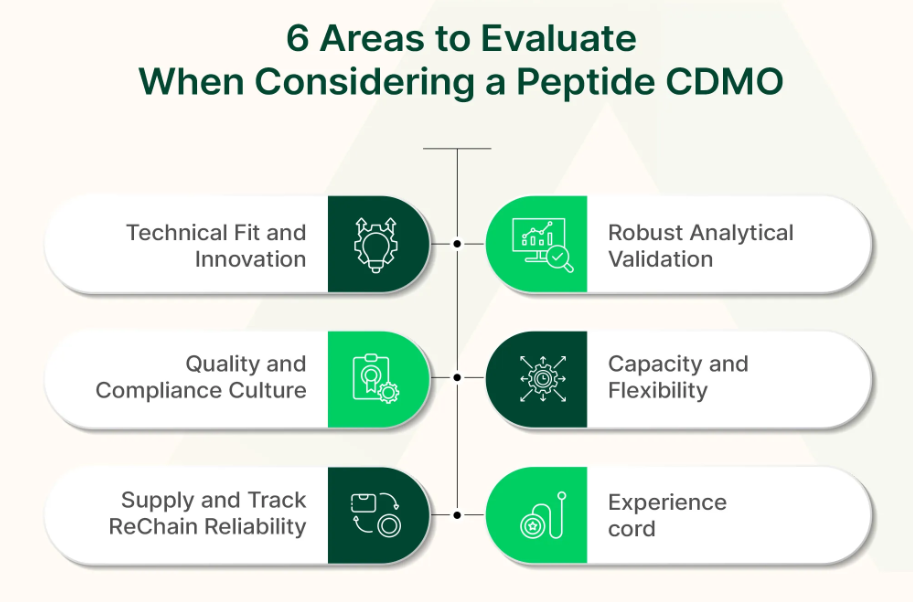
Cost Considerations
While cost is always important, the cheapest option may not represent the best value. Consider total cost of ownership, including:
- Development costs and timeline
- Manufacturing costs per batch
- Quality testing and analytical services
- Regulatory support
- Stability studies
- Potential rework or batch failure costs
Hidden costs can erode apparent savings. Technology transfer delays, quality issues requiring remediation, or capacity constraints forcing last-minute sourcing changes create unexpected expenses.
Request detailed cost breakdowns and understand pricing models. Some CDMOs charge separately for API, analytical testing, and project management. Others offer bundled pricing. Understand what services are included and potential additional charges.
Strategic Alignment
Beyond technical capabilities and costs, assess cultural fit and strategic alignment. Is the CDMO treating you as a valued partner or a transactional customer? Do they show genuine interest in your program’s success?
Consider the CDMO’s business model and client focus. Some specialize in early-stage development, while others focus on commercial manufacturing. Some prefer long-term partnerships with major pharmaceutical companies, while others support emerging biotechs.
Intellectual property protection is critical. Ensure confidentiality agreements are comprehensive. Understand the CDMO’s policies regarding process improvements and know-how developed during collaboration.
Sustainability and Corporate Responsibility
Environmental, social, and governance (ESG) considerations are increasingly important. Evaluate the CDMO’s:
- Environmental management systems
- Solvent recycling and waste reduction programs
- Energy efficiency initiatives
- Worker safety records
- Community engagement
For companies with strong sustainability commitments, partnering with CDMOs sharing these values ensures alignment across the value chain.
Best Practices for Maximizing Value from Peptide CDMO Partnerships
Wenyong Chen, SVP of ChemExpress CDMO, emphasizes that sponsors should take a strategic, long-term, and collaboration-focused approach when working with peptide CDMOs. The key is to align precisely on capacity needs—most peptide therapeutics require only small commercial volumes, so sponsors should look for CDMOs whose scale and cost structure fit these lower-kilogram demands rather than large, generic capacity claims.

He also stresses the importance of choosing partners with true end-to-end capabilities. Peptides frequently involve unnatural amino acids and complex modifications, making it essential to select a CDMO that can manage everything from regulatory starting materials through commercial GMP manufacturing. This avoids costly tech transfers and reduces operational risk.
For emerging modalities like peptide conjugates, Chen advises ensuring the CDMO can handle all components in-house—the carrier, linker, payload, and conjugation process. Such integrated expertise shortens timelines, streamlines the supply chain, and significantly lowers development risk.
Due Diligence Process
Selecting a peptide CDMO warrants thorough due diligence:
- Request for Information (RFI): Issue detailed questionnaires covering technical capabilities, capacity, quality systems, and experience
- Site Audits: Visit facilities to assess infrastructure, equipment, and operations firsthand
- Technical Discussions: Engage CDMO scientists in detailed conversations about synthesis strategies and analytical approaches
- Quality System Review: Examine standard operating procedures, batch records, and quality metrics
- Regulatory Assessment: Review inspection history and regulatory filing experience
- Client References: Contact current and former clients about their experiences
- Financial Stability: Assess the CDMO’s financial health and ownership structure to ensure long-term viability
Red Flags to Watch
Certain warning signs should prompt careful consideration or disqualification:
- Reluctance to provide references or allow site visits
- Recent regulatory warning letters or import alerts
- High staff turnover in key positions
- Outdated equipment or facilities in poor condition
- Vague or evasive responses to technical questions
- Unrealistic promises regarding timelines or capabilities
- Lack of experience with peptides of similar complexity
- Insufficient capacity or unclear expansion plans
Decision Framework
Create a structured evaluation framework comparing CDMOs across key criteria:
- Technical capabilities
- Quality and regulatory compliance
- Capacity and scalability
- Experience and track record
- Communication and project management
- Cost and value
Score each CDMO objectively against these criteria. This systematic approach reduces bias and facilitates stakeholder alignment on the final selection.
Key Takeaways
The peptide therapeutics market represents one of the pharmaceutical industry’s most dynamic growth sectors, driven by breakthrough therapies for metabolic diseases, cancer, and rare disorders. With market values projected to reach USD 4.66 billion by 2030, peptides have overcome historical limitations through technological innovations in synthesis, chemical modification, and delivery.
The CDMO sector plays an increasingly critical role as pharmaceutical companies outsource complex peptide manufacturing to specialized partners. Contract manufacturing services for peptides are expected to grow at double-digit CAGRs, reflecting both market expansion and the technical sophistication required for commercial production.
Successful peptide drug development requires careful CDMO partner selection based on technical capabilities, regulatory experience, scalability, and strategic alignment. As the peptide therapeutics landscape continues to evolve, organizations that establish strong CDMO partnerships while investing in next-generation technologies will be best positioned to capitalize on this transformative therapeutic modality.
Frequently Asked Questions (FAQ)
What are peptides used for in the pharmaceutical industry?
Peptides serve as therapeutic agents for diverse medical conditions including metabolic disorders (diabetes, obesity), cancer, rare gastrointestinal diseases, cardiovascular conditions, neurological disorders, infectious diseases, and hormone replacement therapy. Their high specificity and ability to target cell receptors with precision make them valuable alternatives to traditional small molecule drugs and biologics.
What are the four types of peptides?
Peptide therapeutics can be categorized in multiple ways. One classification includes: (1) Native peptides—identical to naturally occurring sequences; (2) Analog peptides—modified versions with amino acid substitutions to improve properties; (3) Heterologous peptides—derived from different species; and (4) Synthetic peptides—designed de novo without natural templates. Another classification distinguishes peptide hormones, antimicrobial peptides, neuropeptides, and signal peptides based on biological function.
How are peptide drugs manufactured?
Peptide drugs are manufactured primarily through solid-phase peptide synthesis (SPPS), where amino acids are sequentially added to a growing peptide chain attached to a solid resin support. Alternative methods include liquid-phase synthesis and recombinant DNA technology using biological expression systems. After synthesis, peptides undergo purification via high-performance liquid chromatography, followed by lyophilization (freeze-drying) and rigorous analytical testing before formulation into drug products.
What is the difference between API and peptide?
Active Pharmaceutical Ingredient (API) refers to any biologically active component in a drug formulation responsible for therapeutic effect. A peptide API is a specific type of API consisting of amino acid chains. In other words, “peptide” describes the chemical class (amino acid polymers), while “API” indicates the functional role as the active drug substance. APIs can be small molecules, biologics, or peptides. Peptides represent a distinct category of APIs with unique manufacturing requirements, typically produced through chemical synthesis or biotechnology rather than traditional chemical synthesis used for most small molecule APIs.
Recent Peptide CDMO News
BioDuro Launches New Peptide Business Unit to Advance Global Drug Discovery (Nov 2025)
Lifecore Biomedical and PolyPeptide Partner to Deliver Integrated Peptide Manufacturing Solutions (October 2025)
SK pharmteco Invests $6.1M in U.S. Peptide Development and Manufacturing Expansion (October 2025)
Polypeptide Group Expands Ambernath Facility, Tripling Production Capacity (October 2025)
Syngene International Launches State-of-the-Art Bengaluru Peptide Lab for Scalable Synthesis (October 2025)
PolyPeptide Expands Capacity at Belgium Site with Customer Financing (September 2025)
PolyPeptide Group Installs Pre-Built Modules in Malmö €100M CDMO Project (September 2025)
Cambrex Enhances Peptide Capabilities with Waltham Facility Expansion (August 2025)
BioDuro and Atombeat Launch AI Platform for Peptide Drug Discovery (July 2025)
CordenPharma Expands Peptide Platform with >€500m Greenfield Facility Construction (March 2025)
Granules India to Acquire Swiss CDMO Senn Chemicals for Peptide Expansion (February 2025)
Download our CDMO News Tracker to stay ahead of every shift in the CDMO landscape.



